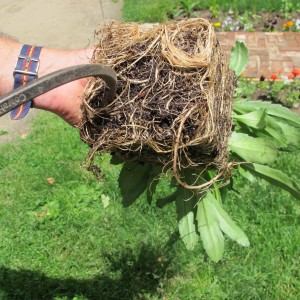Planting Flowers
I love flowers, all kinds of flowers. I probably spend more than I should on seeds, annual flowers in 6-packs, 4-inch pots of trademarked annuals at $5 a pop, perennials, and flowering trees and shrubs. I can get a “runner’s high” just by installing flowers in a new garden space. When I went outside on June 17 with a notebook and a camera, I had 57 species of flowers in bloom, and many more on the way.
I’d guess I planted my first flowers when I was five. Probably some sunflower or morning glory seeds at my Grampy’s home in Spencer, Massachusetts. I spent part of every summer with him from the time I was six until he died on my twenty-first birthday in April of 1967.
But having nice flower beds is more than just buying flowers. Soil preparation and planting make the difference between “bodacious” and “barely bumbling by”. My grandfather was an organic gardener long before it was fashionable, and he taught me how to grow things well by example. He made compost and used it to nourish his soil – and his plants.
Soil can almost always be improved by adding compost. I buy it by the truck load because even the most dedicated gardener rarely has enough. Unless you quit your day job to work on your compost pile, you’ll need to buy compost. It’s rare that you can make enough from left over kitchen scraps and garden waste. For small projects, bagged compost is fine, but most garden centers and many dairy farmers sell it by the pick-up truck load at a reasonable cost.
When preparing a new bed I weed it, and then add 2 to 6 inches of compost on top and mix it in everywhere. This also loosens the soil, getting it ready for plants that have fine root hairs that do the work of penetrating the soil to get moisture and minerals. Soil needs to be loosed to a depth of at least 8 inches, so a garden fork is a good tool to use.
Even if the soil is already dark and rich, I still add a shovel of compost to the planting hole. Perennials get some organic fertilizer, too – half a cup or so in an 18-inch diameter planting hole. Many annuals like lean soil (with little nitrogen, a key ingredient of fertilizers) – so I don’t generally give them any fertilizer. And I don’t fertilize trees and shrubs at planting time – I don’t want them to put on much new growth their first year. And Mother Nature grows tree just fine without fertilizer, you know.
I like organic fertilizers because they provide lots of different minerals that are not present in chemical fertilizers, and they release their nutrients slowly. Pro-Gro is a good one made in Vermont, and Garden-Tone is another nice one. Be careful not to add too much chemical fertilizer if you go that route – it can burn root hairs.
If you’re planting something that has roots that are tangled up or circling the root ball, you will need to loosen them – either with your fingers, or with a hand tool. I like the CobraHead weeder (www.CobraHead.com) for it – it’s my steel finger. At this time of year annuals that come in 6-packs are notorious for roots that are all tangled up. I don’t worry about breaking a few roots in the process of teasing them apart – that will just stimulate them to grow. If you just plop a plant with tangled roots into the soil, the plant might never figure out how to get its roots out into the soil.
Be sure to read the planting guide on the tag from the nursery. Full sun is 6 hours of sun or more each day. Part shade means morning sun, but not hot afternoon sun, or sun filtered through a light canopy of leaves. You can grow full sun flowers in part sun, but they will not flower as much.
Grampy was frugal. He loved his garden, but he didn’t go to garden centers to buy plants – but of course, there really weren’t many back in the fifties and sixties. He started much from seed, and he divided and shared perennials with others, and I imagine he got plants from friends, too.
But if you get flowers from friends, be sure you are not getting the roots of noxious weeds with your gift plant. Study the roots carefully, and pull out anything that is not attached to your new perennial. If your friend’s garden has goutweed, don’t accept any plants, especially iris (which seems prone to bringing goutweed roots tangled in its own). Color is a good way to identify weed roots – they are often different than roots of a perennial flower.
My older sister, Ruth Anne, quoted Grampy as saying, “When you move a plant, dig it up enough soil with it so that it will remember where it came from.” That’s good advice. Soil differs from location to location, and the microbes that favor a perennial at my house might not be present at yours – unless you introduce them.
Lastly, water! New plants need soil that is lightly moist. Check your plants daily, and create a moat of soil around the plants to catch your water, especially on hillsides. Be good to your flowers, and they will reward you handsomely.
Henry is a gardening consultant, coach and the author of 4 gardening books. His web site is www.Gardening-guy.com.



